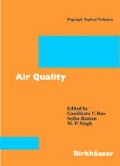Abstract
The CSIRO Division of Atmospheric Research limited area model (DARLAM) is applied to atmospheric transport modeling of haze in southeast Asia. The 1998 haze episode is simulated using an emission inventory derived from hotspot information and adopting removal processes based on SO2.
Results show that the model is able to simulate the transport of haze in the region. The model images closely resemble the plumes of NASA Total Ozone Mapping Spectrometer and Meteorological Service Singapore haze maps. Despite the limitation of input data, particularly for haze emissions, the three-month average pattern correlation obtained for the whole episode is 0.61. The model has also been able to reproduce the general features of transboundary air pollution over a long period of time. Predicted total particulate matter concentration also agrees reasonably well with observation.
The difference in the model results from the satellite images may be attributed to the large uncertainties of emission, simplification of haze deposition and transformation mechanisms and the relatively coarse horizontal and vertical resolution adopted for this particular simulation.
Access this chapter
Tax calculation will be finalised at checkout
Purchases are for personal use only
Preview
Unable to display preview. Download preview PDF.
References
Andreae, M.O.Biomass burning: Its history, use and distribution and its impact on environmental quality and global climate. In Global Biomass Burning: Atmospheric, Climatic, and Biospheric Implications(ed. Levine, J.) (The MIT Press, Cambridge, Mass. 1991) pp. 3–21.
Arakawa, A. (1972)Design of the UCLA General Circulation Model. Numerical Simulation of Weather and Climate,Technical Report No. 7, Dept. of Meteorology, University of California, Los Angeles.
Berge, E. (1993)Coupling of Wet Scavenging of Sulfur to Clouds in a Numerical Weather Prediction Model,Tellus 45B, 1–22.
Bermejo, R. and Staniforth, A. (1992)The Conversion of Semi-Lagrangian Advection Schemes to Quasi-Monotone Schemes,Mon. Wea. Rev. 120, 2622–2632.
Braak, C. (1929)Transparency of the air: Haziness.In The Climate of the Netherland Indies; Volume 1.Verhandelingen No. 8,Koninklijk Magnetisch en Meteorologisch Observatorium te Batavia, 190–198.
Davies, H.C. (1976)A Lateral Boundary Formulation for Multi-Level Prediction Models,Quart. J. Roy. Meteor. Soc. 102, 405–418.
Dorman, J.L. and Sellers, P.J. (1989)A Global Climatology of Albedo, Roughness Length and Stomatal Resistance for Atmospheric General Circulation Models as Represented by the Simple Biosphere Model (SiB),J. Appl. Meteor. 28,833–855.
Feichter, J., Kjellstrom, E., Rodhe, H., Dentener, F., Lelieveld, J. and Roeloffs, G.J. (1996)Simulation of the Tropospheric Sulfur Cycle in a Global Climate ModelAtmos. Environ. 301693–1707.
Fels, S.B. and Schwartzkopf, M.D. (1975)The Simplified Exchange Approximation: A New Method For Radiative Transfer Calculations,J. Atmos. Sci. 32, 1475–1488.
Geleyn, J.F. (1987)Use of a modified Richardson number for parameterizing the effect of shallow convection. In Short-and Medium-Range Numerical Weather Prediction(ed. Matsuno T.), Special Volume of the J. Meteor. Soc. Japan, 233–246.
Giorgi, F. and Chameides, W. (1986)Rainout Lifetimes of Highly Soluble Aerosols and Gases as Inferred from Simulations with a General Circulation Model,J. Geophys. Res. 91, D13, 14,367–14,376.
Heil, A., Stolle, F., Mahmud, M., and Elfian, E. (1998)Air Pollution from Large Scale Forest and Land Fires in Indonesia 1997/98: Development and Impacts.Draft document for the SEA-SPAN Electronic Conference on Transboundary Air Pollution, Oct. 1998http://www.icsea.or.id/sea-span/scipol2/study42.html/sea-span/scipol2/study42.html
Kowalczyk, E.A., Garratt, J.R., and Krummel, P.B. (1994)Implementation of a Soil Canopy Scheme into the CSIRO GCM - Regional Aspects of the Model Response,CSIRO Atmospheric Research Tech. Paper No. 32, 59 pp.
Levine, J.S. (1999)The 1997 fires in Kalimantan and Sumatra, Indonesia: Gaseous and Particulate Emissions,Geophys. Res. Lett. 26, 815–818.
Louis, J.F. (1979)A Parametric Model of Vertical Eddy Fluxes in the Atmosphere,Boundary-Layer Meteor. 17, 187–202.
Mcgregor, J.L. (1987)Accuracy and Initialization of a Two-time-level Split Semi-Lagrangian Model.Short-and -medium-range Numerical Weather Prediction (ed. T. Matsuno), Special Volume of the J. Meteor. Soc. Japan, 233–246.
Mcgregor, J.L. (1993)Economical Determination of Departure Points for Semi-Lagrangian Models,Mon. Wea. Rev. 121, 221–230.
Mcgregor, J.L., Gordon, H.B., Watterson, LG., Dix, M.R., and Rotstayn, L.D. (1993)The CSIRO9-level Atmospheric General Circulation Model,CSIRO Atmos. Res. Tech. Paper No. 26,89 pp.
Robertson, L., Rodhe, H., AND Granat, L. (1995)Modelling of Sulfur Deposition in the Southern Asian Region,Water, Air and Soil Pollution 85, 2337–2343.
Siegert, F. and Hoffmann, A. (1998)Evaluation of the 1998 Forest Fires in East-Kalimantan (Indonesia) Using multi-temporal ERS-2 SAR Images and NOAA-AVHRR Data,as presented at the International Conference on Data Management and Modelling Using Remote Sensing and GIS for Tropical Forest Land Inventory, Jakarta, Indonesia, 26–29 October 1998.
Thuburn, J. (1993)Use of a Flux-limited Scheme for Vertical Advection in a GCM,Quart. J. Roy. Meteor. Soc. 119, 469–487.
UNEP (1999), LEVINE, J.S., BOBBE, T., RAY, N., SINGH, A., and WITT, R.G.Wildland Fires and The Environment: A Global Synthesis,UNEP/DEIAEW/TR.99–1.
Van Leer, B. (1974)Towards the Ultimate Conservative Difference Scheme. II: Monotonocity and Conservation Combined in a Second Order Scheme,J. Comput. Phys. 14, 361–370.
Von Hoyningen-Huen E, W., Schmidt, T., Schienbein, S., Kee, C.A., and Tick, L. J. (1999)Climate-relevant Aerosol Parameters of South-East Asian Forest Fire Haze,Atmos. Environ. 33,3183–3190.
Ward, D.Factors influencing the emissions of gases and particulate matter from biomass burning.In Fire inthe Tropical Biota: Ecosystem Processes and Global Challenges(ed. J.G. Goldammer) (Springer-Verlag, Berlin 1990), Ecological Studies, vol. 84, pp. 418–436.
Zobler, L. (1988)A World Soil File for Global Climate Modeling.NASA Tech. Memo. 87802 [available from NASA Goddard Institute for Space Studies, 2880 Broadway, New York, NY 10025].
Author information
Authors and Affiliations
Editor information
Editors and Affiliations
Rights and permissions
Copyright information
© 2003 Springer Basel AG
About this chapter
Cite this chapter
Koe, L.C.C., Arellano, A.F., McGregor, J.L. (2003). Application of DARLAM to Regional Haze Modeling. In: Rao, G.V., Raman, S., Singh, M.P. (eds) Air Quality. Pageoph Topical Volumes. Birkhäuser, Basel. https://doi.org/10.1007/978-3-0348-7970-5_11
Download citation
DOI: https://doi.org/10.1007/978-3-0348-7970-5_11
Publisher Name: Birkhäuser, Basel
Print ISBN: 978-3-7643-7005-3
Online ISBN: 978-3-0348-7970-5
eBook Packages: Springer Book Archive

